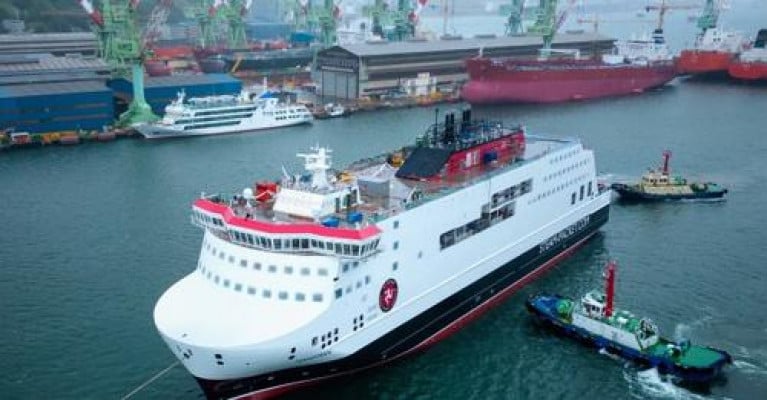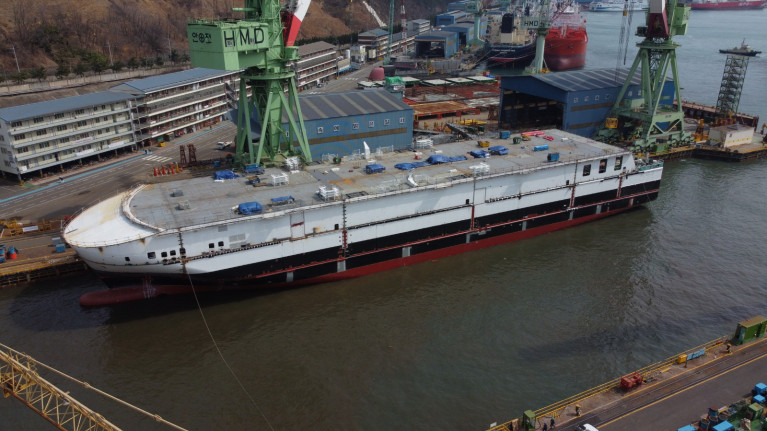Displaying items by tag: Manxman
Last week, the Isle of Man Steam Packet announced a change of ferry for day-time crossings on its Douglas-Heysham route.
As Manx Radio wrote, those travelling on the IOM-England route on Monday (15 April) will be on board the ropax Ben-my-Chree, which was withdrawn from service last year when replaced by the £80m newbuild flagship, Manxman.
According to the company, the change of ferry is due to planned maintenance of safety equipment, with the former flagship operating the Manxman's daytime sailings. The route takes 3 hours 45 minutes.
On Friday, the Ben-my-Chree returned to Manx waters having departed dry-dock at Cammell Laird, Birkenhead in Merseyside, where the 1998-built ropax had been having an overhaul and repaint.
To find out the latest sailing information, click here.
The £80m flagship of the Isle of Man Steam Company the Manxman will be out of commission for four days in the coming months.
According to the IOMSPCo. the ferry which operates the Douglas-Heysham route will undergo planned servicing of its Marine Evacuation System (MES).
As Manx Radio reports, the four days that the 946 passenger flagship will not be operating are to take place on 26 March, 15 April, 25 April and 7 May.
While the 24,161 gross tonnes Manxman is off service there will be no disruption to passenger services, as the fast-craft ferry Manannan or ropax Ben-my-Chree will take over the flagship’s sailings for these dates.
The servicing of the MES is a routine annual requirement for all vessels with the Ben-my-Chree expected to undertake its planned annual maintenance and inspection in March and April.
Manannan’s overhaul at Cammell Laid, Birkenhead along with a cabin refit has been taking place over the winter ahead of its return to service at the end of March.
New Isle of Man Flagship Ferry Will Soon Sail at Full Passenger Capacity
The new Isle of Man Steam Packet ferry, the Manxman which operates on the Douglas-Hesyham route will soon be able sail at full capacity which is 948 passengers.
Since entering service in August, the Steam Packet's £78m newbuild flagship of 24,161 gross tonnes has been sailing with a passenger capacity currently limited to 600 while final crew training was completed.
That's almost the capacity of the 630 passenger Ben-my-Chree, with the 1998 built ropax having had to step in to cover the Isle of Man-England crossings when wind-restrictions prevented the 237 car carrying Manxman from sailing.
Alex Allinson, the Manx Treasury Minister told a House of Keys sitting yesterday, that restrictions are about to change.
Manx Radio has the story along with a link to an audio clip of the Minister.
Since the Isle of Man Steam Packet’s newbuild flagship ferry entered service in August, how many times has its predecessor the ropax Ben-My-Chree been drafted in to carry out its sailing roster.
As 3FM reports, this question is to be asked in the House of Keys today by Jason Moorhouse MHK, as part of a trio of Steam Packet related questions tabled for the Manx Treasury Minister, Dr Alex Allinson.
In recent months there have been numerous occasions where weather related conditions have forced the £78m Manxman from not sailing the Douglas-Heysham route leading the 1998 built Ben-My-Chree to cover the service so to maintain operations.
Further questioning from the Arbory, Castletown and Malew MHK will inquire about the difference in fuel consumption between the 948 passenger Manxman and the 630 capacity Ben-my-Chree.
As both ferries operate the same Isle of Man-England route and running in similar conditions, the question of how long each crossing took will also be asked at the sitting.
Manxman, the new 24,161 gross tonnage flagship ferry which was built in an Asian shipyard for the Isle of Man Steam Company, has said that they "won't rush" to have things ready.
The first passenger sailing on the Douglas-Heysham route reports ManxRadio is now 'weeks rather than months' away from entering service according to the Steam Packet Company's managing director.
Brian Thomson says the company "won't rush things to have Manxman in service before it is ready".
In a general update released yesterday on the 950 passenger/crew flagship's progress, the Steam Packet had confirmed that the ferry has been issued with a seaworthiness certificate.
In addition the company said that the vehicle decks received an "improved coating" that was applied to both car decks and that crew training has been taking place.
Manxman has completed berthing trials in Douglas and Heysham and made an initial visit to Belfast which Afloat adds took place on Wednesday, exactly a month after making its maiden arrival to the Isle of Man.
The berthing trials at Albert Quay took about an hour to complete and as can be seen in the photo above is the stern berthed next to the linkspan.
Afloat adds that the statement issued by the Steam Packet said the crew of Manxman and shoreside staff have been working tirelessly to develop and implement operating procedures as real-life knowledge of the vessel grows.
In terms of technology, Manxman is a huge step forward from both the ropax Ben-my-Chree and fast-ferry Manannan, as such the crew requires entirely new ways of working.
When Manxman is introduced, for approximately the first four weeks the flagship will only carry out daytime sailings while Ben-my-Chree will run the overnight sailings.
When this period is over, Manxman will undertake the previously announced cruise, before commencing four weeks of night time sailings, with Ben-my-Chree switching to the daytime schedule.
At the conclusion of the working up period, Manxman will take over fully on the Douglas-Heysham route, replacing the 12,747 gross tonnage Ben-my-Chree which has been in service for 25 years.
The 600 passenger custom-built 'Ben' dating from 1998 will then enter fleet reserve status.
Manxman the new flagship ferry of the Isle of Man Steam Packet has finally arrived in UK waters, having berthed in Southampton.
The largest ferry ever built for the Steam Packet had set off from the South Korean shipyard of Hyundai Mipo Dockyard where during a ceremony the newbuild was transferred to the company on 11 May.
Two days later under the charge of Captain Andy Atkinson and Chief Engineer Dean Ellis, Manxman departed the shipyard on its delivery voyage.
The newbuild took a route via the Suez Canal as part of the voyage that took approximately 23 days at sea, and steamed over 10,000 nautical miles.
Manxman is to remain in the south of England port in Hampshire to enable final fixtures and fittings to be added, including the children’s play area.
Isle of Man Today has further details of the newbuild which is to serve the main Douglas-Heysham route.
Manxman Officially Joins Isle of Man Steam Packet Fleet at Shipyard Handover Ceremony in South Korea
Manxman the newbuild flagship of the Isle of Man Steam Packet Company has officially joined the fleet during a transfer of ownership ceremony that took place in a shipyard in South Korea.
At a ceremony held at the Hyundai Mipo Dockyard (HMD), Lars Ugland, Chairman of the Board of the IOM Packet Co, signed the official documentation to complete the transfer of ownership on behalf of the Company.
The documentation to mark the transfer of the largest ferry built for the Steam Packet was completed at 11:40 South Korea time (03:40 BST) on the 11th May.
Mr HR Kim, President and CEO of Hyundai Mipo Dockyard also signed on behalf of the shipbuilders.
The historic moment brings to a close the newbuild phase of the project that began with the selection of Hyundai Mipo Dockyard in July 2020.
As Afloat reported, sea trials were completed at the end of April and the Manxman is now in the charge of Captain Andy Atkinson and Chief Engineer Dean Ellis.
Final preparations for departure of the 23 delivery voyage from Asia to Europe is to start tomorrow, 13 May.
During the voyage, six ports of call will be involved before arriving in UK waters, however this will firstly be to a port on the south coast of England.
This is to enable installation of final fixtures and fittings.
It is expected the Manxman will arrive in the Isle of Man ‘towards the end of June’, said the Steam Packet.
The Manxman Afloat adds is to replace the 25 year old Ben-My-Chree which was also custom-built for the company in 2008 at a Dutch shipyard.
The 'Ben' since then has been the main ferry operating the Douglas-Heysham route and during peak times operates seasonal sailings to Belfast.
In the early years, the ropax had also called to Dublin port, again during busy times.
New Flagship Ferry Manxman Undertakes First Sea Trials in South Korea
The new flagship of the Isle of Man Steam Packet Company the Manxman, has undergone its first sea trials in South Korea.
The newbuild set sail from the port of Ulsan from where the Hyundai Mipo Dockyard built the ferry. Among the tests involved the propulsion equipment, controls, mooring, navigation, radio and anchor equipment.
Manxman is to continue with further trials which will take place nearer to the newbuid's completion which will test stabilisers, speed and levels of sound and vibration.
Following completion as Afloat previously reported the Manxman will embark on an 18,000 mile delivery voyage to the Isle of Man. This is expected to take 30 days with a transit through the Suez Canal.
Click ManxRadio which also has a video of Manxman underway.
It is hoped that the ferry can enter service ahead of the 2023 TT Festival.
The new Isle of Man Steam Packet Company's ferry has reached the completion phase of dry-building at an Asian shipyard with the company celebrating this key event of the Manxman's construction process.
Despite the extreme challenges posed by the global COVID-19 pandemic, Manxman floated out of drydock on 14th June, exactly on schedule. The custom-built ferry was taken by tugs to an outfitting berth where the next phase of the build has commenced.
The official certificate of launching was presented to Jim Royston, Isle of Man Steam Packet Company’s Fleet Operations and Project Manager, in a ceremony held to mark the occasion by HD Shin, President and CEO of HMD Dock Yard.
Brian Thomson, Managing Director of the Steam Packet Company, said: ‘The contract with the shipyard was signed two years ago now, in that contract 14th June 2022 was specified for the launch of Manxman and we are immensely proud as a company, to have achieved that milestone. This has been achieved despite facing closed borders, travel restrictions and global supply chain issues. For everyone working on the project this is a remarkable achievement.’
‘We look forward to sharing details of Manxman’s continued development and ultimate delivery to Manx waters in 2023.”
Afloat.ie adds the Manxman is to enter service on the company's main year round operated Douglas-Heysham route where the Manx-England link is currently served by ro-pax Ben-My-Chree which entered service in 1998.
To keep abreast of further phases on the Manxman, the Steam-Packet has a blog for the latest progress updates.
Newbuild Manxman Floats For First Time in South Korea
The new Isle of Man Steam Packet Company's vessel has successfully floated for the first time.
The Manxman is currently under construction in a South Korean shipyard, and is set to replace the Ben-my-Chree when it enters service (in Spring, 2023).
In a social media post, the Steam Packet has shared pictures of the ferry's first time floating on the water.
As 3FM writes, you can keep up with further updates on the vessel, which is set to arrive next spring, on the company's blog here.
Afloat adds the 133m long newbuild at the Hyundai Mipo Dockyard in Ulsan, will replace the 'Ben' next year, relegating the 1998 built ro-pax to backup duties.
This role is carried out albeit by the freight-only ferry Arrow on the main Douglas-Heysham route.






























































